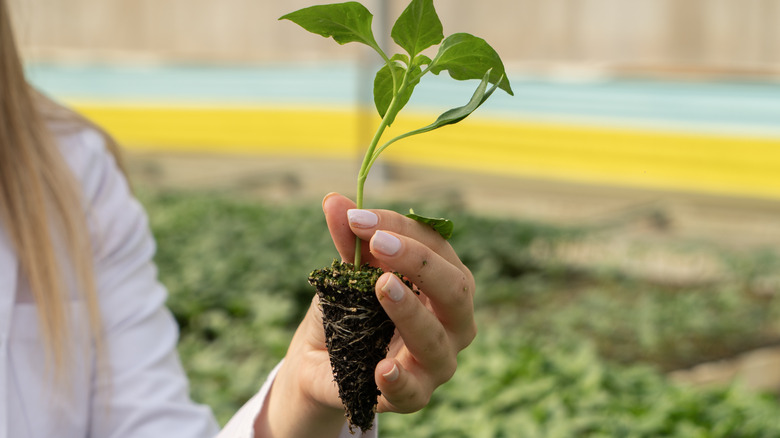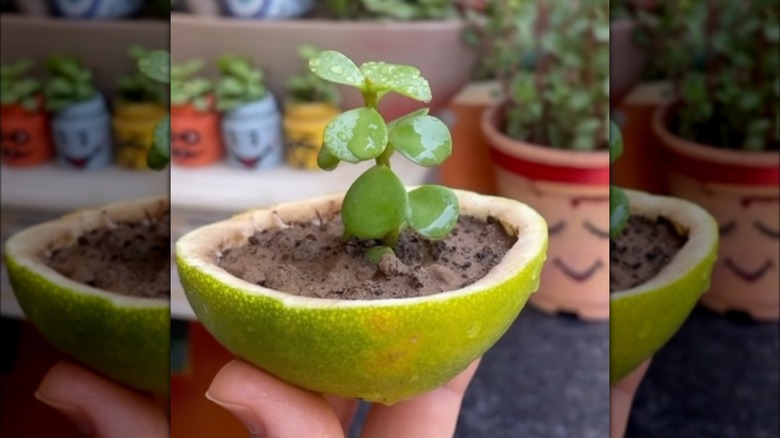Why You'll Want To Start Seedlings In A Citrus Peel Before Planting Them
Starting seeds in small vessels before transplanting them to a garden is an essential step for gardeners each spring. This method allows for better control of environmental conditions like temperature and humidity, promoting optimal germination and early growth. Secondly, it prevents competition among seedlings, ensuring each plant receives adequate nutrients and space to flourish. Many gardeners choose to start seedlings in cheap plastic containers or seed pods and then transplant them into a garden. What you probably don't know is that you actually have an even more affordable and sustainable option in your kitchen already.
The next time you make fresh orange juice for breakfast save that citrus peel for an eco-friendly seed starter! Rather than purchasing one-time-use plastic trays, a citrus peel you already have is a wonderful option for starting your garden plants, and it even adds a bright pop of color to your home while your seeds germinate. Choose from any citrus you may have in your kitchen like grapefruits, blood oranges, or lemons. Add a scoop of soil and you're ready to go!
How to start seedlings in a citrus peel
Starting seeds in a citrus peel is a fun and environmentally-friendly way to grow plants for your garden. It also provides the seeds with essential nutrients from the peel, promoting early growth. Collect organic, fresh, healthy citrus fruits and slice them in half, carefully removing the flesh but leaving the white pith intact. The pith acts as a natural barrier to hold moisture and provide nutrients to the seeds. Use a toothpick or small skewer to make a few drainage holes in the bottom of the citrus peel. Adequate drainage prevents waterlogging, which can be detrimental to seedlings. Fill the citrus peel with a well-draining potting mix, leaving enough space at the top for watering. Use a mix suitable for starting seeds, light and loose to encourage root growth.
Plant one or two seeds per citrus peel, pushing them slightly into the soil but not burying them too deep. Cover them lightly with soil. Place the citrus peel pots in a warm location with indirect sunlight. Mist the soil lightly with water to keep it consistently moist but not soggy. Once your seedlings have developed a few sets of true leaves, transplant them, along with the citrus peel, into larger pots or directly into the garden soil. Continue to provide appropriate sunlight, water, and nutrients as the seedlings grow. Over time, the citrus peel will naturally decompose, so you do not need to remove it while transplanting.
Why it works
Starting seeds in a citrus peel is advantageous to both the plant and the environment for a few reasons. First, citrus peels contain essential nutrients like potassium, phosphorus, and nitrogen. As the peel decomposes, it releases these nutrients into the soil, providing a natural and organic source of fertilization for the growing seedlings. This nutrient-rich environment promotes healthy root development, vigorous growth, and overall plant vitality. At the same time, the white pith of the citrus peel acts as a moisture-retentive layer, preventing the soil from drying out quickly and maintaining consistent moisture levels around the seeds.
Additionally, using citrus peels as seed starters reduces the need for plastic or synthetic containers, which often end up in landfills and contribute to environmental pollution. The biodegradable nature of citrus peels means they can break down naturally over time, further reducing waste. Simultaneously, growing seeds in citrus peels is a cost-effective method, as it requires minimal additional materials. It utilizes a byproduct that might otherwise have been discarded, turning it into a valuable resource for gardening. Finally, transplanting seedlings along with the citrus peel reduces the risk of transplant shock. The peel provides some protection and stability to the delicate young plants as they adjust to their new environment. So before you toss your used citrus into your compost pile, consider saving them for seed starting!

